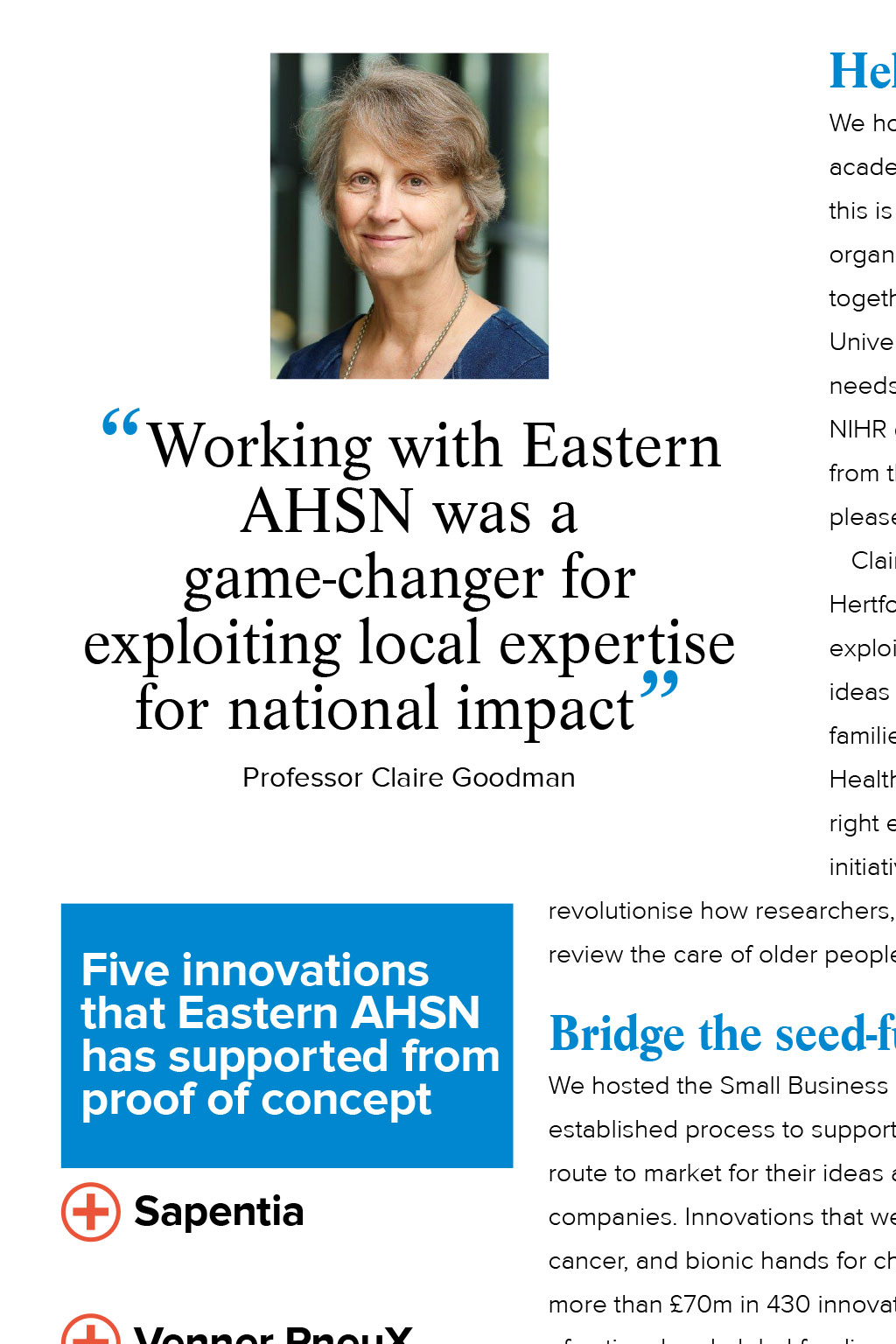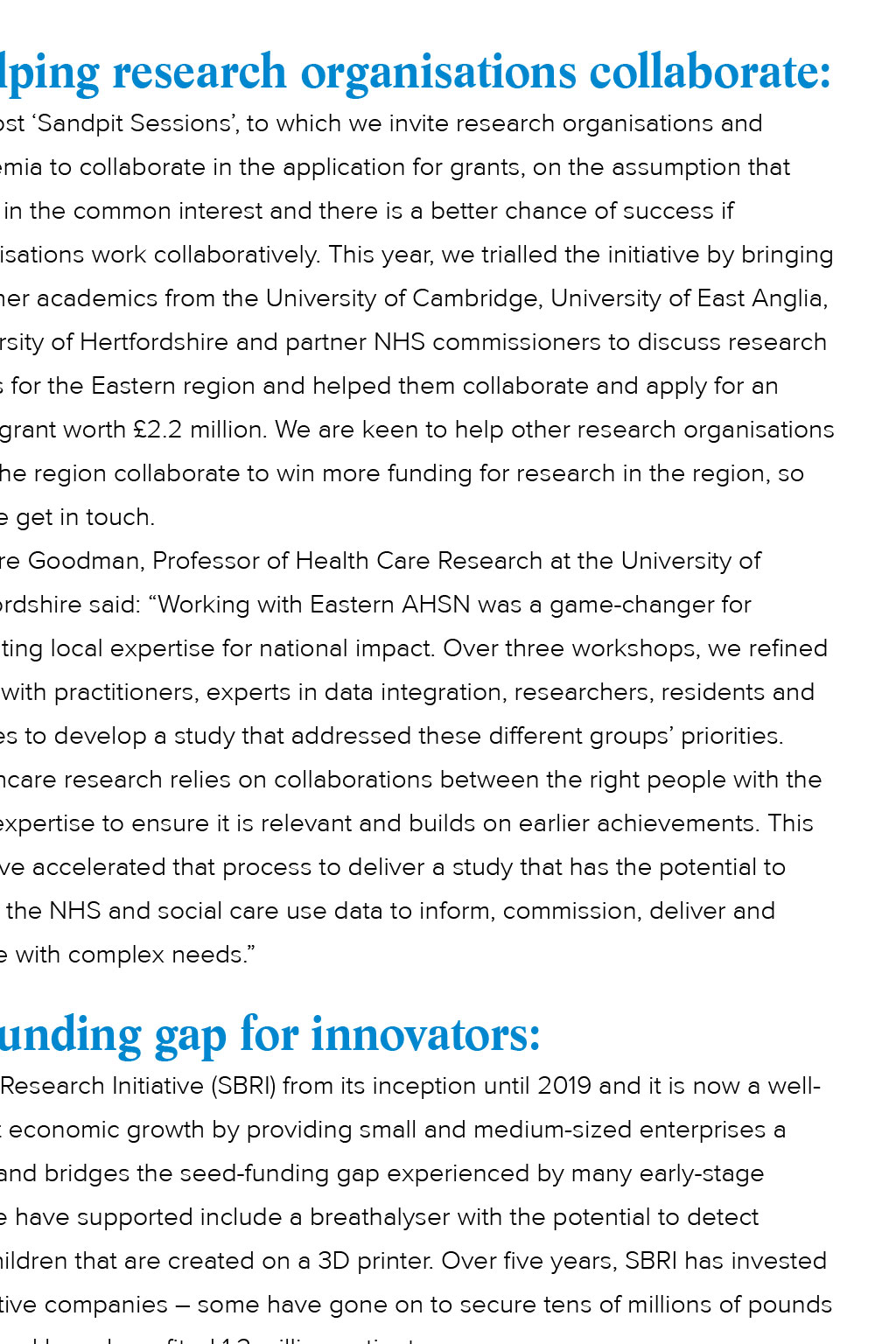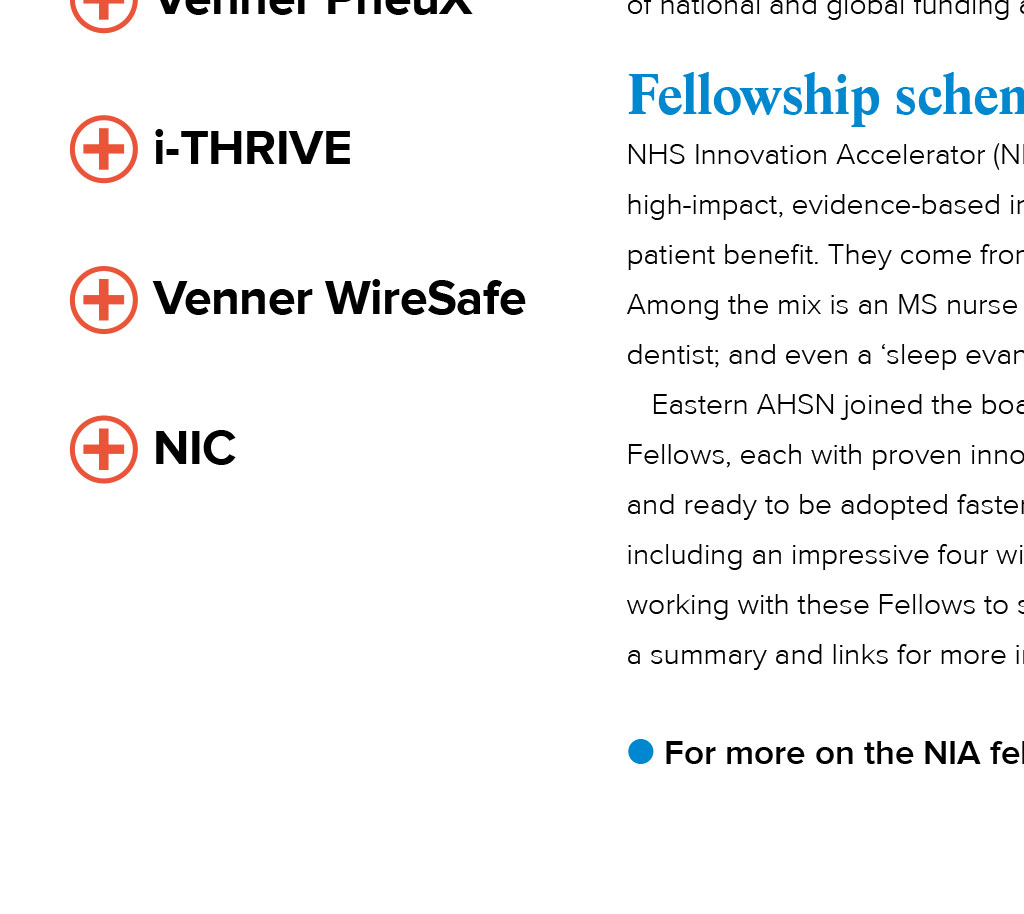














Collaboration: Investing in innovators Our impact: driving investment into the East One of our objectives is to bring investment into the Eastern region and help innovators secure the funding they need to grow. We achieve this through a number of routes including: “Working with Eastern AHSN was a game-changer for exploiting local exper”tise for national impact Professor Claire Goodman Helping research organisations collaborate: We host ‘Sandpit Sessions’, to which we invite research organisations and academia to collaborate in the application for grants, on the assumption that this is in the common interest and there is a better chance of success if organisations work collaboratively. This year, we trialled the initiative by bringing together academics from the University of Cambridge, University of East Anglia, University of Hertfordshire and partner NHS commissioners to discuss research needs for the Eastern region and helped them collaborate and apply for an NIHR grant worth £2.2 million. We are keen to help other research organisations from the region collaborate to win more funding for research in the region, so please get in touch. Claire Goodman, Professor of Health Care Research at the University of Hertfordshire said: “Working with Eastern AHSN was a game-changer for exploiting local expertise for national impact. Over three workshops, we refined ideas with practitioners, experts in data integration, researchers, residents and families to develop a study that addressed these different groups’ priorities. Healthcare research relies on collaborations between the right people with the right expertise to ensure it is relevant and builds on earlier achievements. This initiative accelerated that process to deliver a study that has the potential to Five innovations that Eastern AHSN has supported from proof of concept Sapentia Venner PneuX i-THRIVE Venner WireSafe NIC revolutionise how researchers, the NHS and social care use data to inform, commission, deliver and review the care of older people with complex needs.” Bridge the seed-funding gap for innovators: We hosted the Small Business Research Initiative (SBRI) from its inception until 2019 and it is now a well- established process to support economic growth by providing small and medium-sized enterprises a route to market for their ideas and bridges the seed-funding gap experienced by many early-stage companies. Innovations that we have supported include a breathalyser with the potential to detect cancer, and bionic hands for children that are created on a 3D printer. Over five years, SBRI has invested more than £70m in 430 innovative companies – some have gone on to secure tens of millions of pounds of national and global funding and have benefited 1.2 million patients. Fellowship scheme for innovators: NHS Innovation Accelerator (NIA) Fellows are exceptional individuals being supported to scale their high-impact, evidence-based innovations. Fellows share a passion for learning and scaling innovation for patient benefit. They come from a wide range of backgrounds, including clinical, industry and academia. Among the mix is an MS nurse consultant; an engineer; a former police officer; a respiratory consultant; a dentist; and even a ‘sleep evangelist’. Eastern AHSN joined the board in 2016 and has supported the selection and development of 25 Fellows, each with proven innovations that were identified as addressing key priorities within the NHS and ready to be adopted faster and more systematically. A total of 13 Fellows were selected nationally, including an impressive four with five innovations from the eastern region in 2018/19. We are now working with these Fellows to support evaluation, adoption and spread of their ideas. Please find below a summary and links for more information: ● For more on the NIA fellows visit nhsaccelerator.com Collaboration: Investing in innovators One of our objectives is to bring investment into the Eastern region and help innovators secure the funding they need to grow. We achieve this through a number of routes including: “Working with Eastern AHSN was a game-changer for exploiting local exper”tise for national impact Professor Claire Goodman Helping research organisations collaborate: We host ‘Sandpit Sessions’, to which we invite research organisations and academia to collaborate in the application for grants, on the assumption that this is in the common interest and there is a better chance of success if organisations work collaboratively. This year, we trialled the initiative by bringing together academics from the University of Cambridge, University of East Anglia, University of Hertfordshire and partner NHS commissioners to discuss research needs for the Eastern region and helped them collaborate and apply for an NIHR grant worth £2.2 million. We are keen to help other research organisations from the region collaborate to win more funding for research in the region, so please get in touch. Claire Goodman, Professor of Health Care Research at the University of Hertfordshire said: “Working with Eastern AHSN was a game-changer for exploiting local expertise for national impact. Over three workshops, we refined ideas with practitioners, experts in data integration, researchers, residents and families to develop a study that addressed these different groups’ priorities. Healthcare research relies on collaborations between the right people with the right expertise to ensure it is relevant and builds on earlier achievements. This initiative accelerated that process to deliver a study that has the potential to Five innovations that Eastern AHSN has supported from proof of concept Sapentia Venner PneuX i-THRIVE Venner WireSafe NIC revolutionise how researchers, the NHS and social care use data to inform, commission, deliver and review the care of older people with complex needs.” Bridge the seed-funding gap for innovators: We hosted the Small Business Research Initiative (SBRI) from its inception until 2019 and it is now a well- established process to support economic growth by providing small and medium-sized enterprises a route to market for their ideas and bridges the seed-funding gap experienced by many early-stage companies. Innovations that we have supported include a breathalyser with the potential to detect cancer, and bionic hands for children that are created on a 3D printer. Over five years, SBRI has invested more than £70m in 430 innovative companies – some have gone on to secure tens of millions of pounds of national and global funding and have benefited 1.2 million patients. Fellowship scheme for innovators: NHS Innovation Accelerator (NIA) Fellows are exceptional individuals being supported to scale their high-impact, evidence-based innovations. Fellows share a passion for learning and scaling innovation for patient benefit. They come from a wide range of backgrounds, including clinical, industry and academia. Among the mix is an MS nurse consultant; an engineer; a former police officer; a respiratory consultant; a dentist; and even a ‘sleep evangelist’. Eastern AHSN joined the board in 2016 and has supported the selection and development of 25 Fellows, each with proven innovations that were identified as addressing key priorities within the NHS and ready to be adopted faster and more systematically. A total of 13 Fellows were selected nationally, including an impressive four with five innovations from the eastern region in 2018/19. We are now working with these Fellows to support evaluation, adoption and spread of their ideas. Please find below a summary and links for more information: ● For more on the NIA fellows visit nhsaccelerator.com Our impact: driving investment into the East Sapentia Andrea Haworth, Head of Clinical Services at Congenica, secured a £10m grant to progress genome analytics enabling rapid identification. This is now being used by half of all genomic medicine centres in the UK and to analyse data from the 100,000 Genome Project. On average, it takes five years to diagnose a rare disease and, during that time, a patient will have seen, on average, seven clinicians and could have been misdiagnosed. This analytics software has been developed to enable one clinician to make a diagnosis within five days. Venner PneuX Peter Young, Consultant, Intensive Care, at the Queen Elizabeth King’s Lynn NHS Foundation Trust, is a serial innovator. His pneumonia prevention system is designed to stop ventilator- associated pneumonia – a leading cause of mortality in intensive care units. i-THRIVE Anna Moore, Specialty Registrar in Child and Adolescent Psychiatry, University of Cambridge. The i-THRIVE programme aims to improve outcomes for children and young people’s mental health and wellbeing by working with CCGs, NHS Trusts, local authorities and charities across the country to implement the THRIVE Framework for system change. The programme, which is endorsed by the NHS Long Term Plan, places an emphasis on prevention and early intervention, shared decision-making and community involvement. Venner WireSafe Maryanne Mariyaselvam, Clinical Research Fellow at The Queen Elizabeth King’s Lynn NHS Foundation Trust and Addenbrooke’s Hospital, Cambridge, received the British Empire Medal in June for services to healthcare. She has developed a number of devices to improve patient safety, including WireSafe, which prevents accidental guidewire retention when a patient has a central line inserted. Retained guidewires have a reported incidence of 1 in 3,000 procedures and a mortality of up to 20 per cent. NIC – Non-Injectable Arterial Connector This is another of Maryanne Mariyaselvam’s innovations – a low-cost simple device that stops wrong-route drug administration, reduces arterial line-related infections and prevents blood loss during sampling.